
Background information
Trains, goals and future plans: visiting Urban Games in Schaffhausen
by Debora Pape

The Swiss video game scene is ripe for expansion. Developer and designer Pierre Lippuner agrees. Joined by team member Denise Hohl, he talks about his own game and the challenges facing developers.
The colourful Swiss Game Hub strongly contrasts with a grey Zurich. In this co-working space for game developers, I meet up with Pierre Lippuner and Denise Hohl from studio Ninoko. The third member of the team, Jan Schneider, will be joining us later to play their racing game Ultimate Godspeed. Their passion for game design and the Swiss Game Hub brought the three of them together.
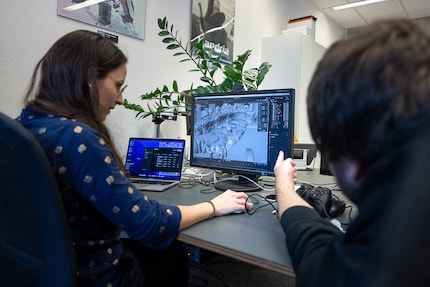
** Let’s start with you, Pierre. Who are you and where are you from? **
Pierre: I’m Pierre Lippuner, from St Gallen. I’m a game developer, both in the analogue and digital field.
** How did you find your way into the video game industry? **
Pierre: Before my apprenticeship as a graphic designer, I wanted to become a comic artist. By chance, however, I met up with the people I’d later launch the card game Frantic with. After becoming friends, they told me about their game idea.
I wanted to design it and offered to do so. Unexpectedly, the game was a huge success. That’s when the passion really hit me for the first time. In contrast to a normal job, being a graphic designer gives me completely different opportunities. As a team, we created an entertaining product. And being able to say, «Hey, I made that game» is a great feeling.
Video games are a 40-year-old medium, and Switzerland’s 30 years behind.
Childhood memories also arose during the project. The card game in the Yu-Gi-Oh! anime interested me much more than the story at the time. So I made my own version with Jass cards (translator's note: Swiss playing cards). That was basically the first game I made.
** And what happened next? **
Frantic was released in 2015. I wanted to continue in that direction and applied to study Game Design at ZHdK – successfully. That’s where I met my current team – Ninoko: Jan Schneider is our programmer and tech genius. Denise is responsible for the design. I take care of design and development myself. In general, however, all three of us do a bit of everything. We just see how it goes in the moment.
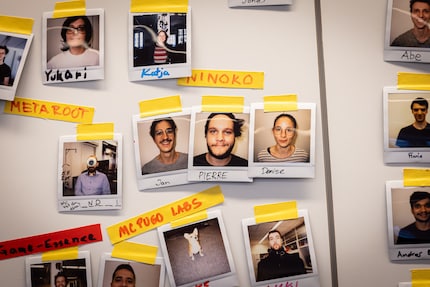
** And what did your path to becoming a game developer look like, Denise? **
Denise: Like Pierre, I previously worked as a graphic designer for about eight years. But despite enjoying it, I wanted to improve and broaden my skills. For example, I was interested in programming and 3D modelling. I came across game design more by chance than anything else. While researching this, I discovered how broad the spectrum of genres is. It’s what prompted me to start my studies at ZHdK. I was in the same year as Pierre.
** How did you end up here at the Swiss Game Hub? **
Pierre: Jan and I completed our bachelor’s degree in 2020. The Swiss Game Hub also opened around that time, so we applied. Just as the pandemic was moving us towards a second lockdown. After Jan and I both failed our bachelor projects, we came up with the idea for our current game together.
Denise: I was an intern at the Swiss Game Hub with Stray Fawn, then joined them.
** How did the Hub come about? **
Pierre: It was founded by three entities. First, Stray Fawn Studio. Then David Stark, who found success with his solo project Airships, a game where you build your own steampunk airships. And last but not least, Ateo. This studio is mainly dedicated to augmented and virtual reality (AR/VR). As an example, the team programmed a virtual art museum.
All three wanted to offer the space to freelance developers and other interested parties with the aim of expanding the Swiss gaming scene. Video games are a 40-year-old medium, and Switzerland’s 30 years behind. True, this might sound a bit harsh, but this should finally change.
** How does the Swiss Game Hub work? **
Denise: On the one hand, it’s a co-working space. You rent a fixed or a flexible workstation. The co-working area tries to cover its own costs through these customers. All other parts are occupied by the larger studios. The space is designed to encourage people to meet and exchange ideas.
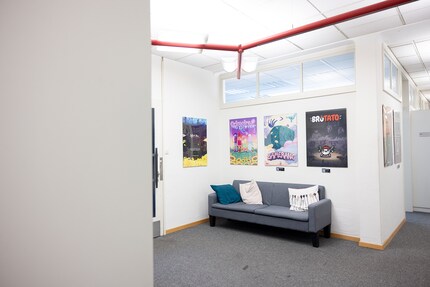
The Hub also offers additional mentoring. You submit your idea and they assess whether it could be successful or not. The important thing here is for an idea to be in demand on the market – and to promise a certain degree of success.
** How exactly does mentoring work in the Hub? **
Denise: In mentoring, we have an evaluation every six months. There we present the current status of our project and upcoming goals. Alternatively, we can also approach our mentors if something comes up or we get stuck. That’s up to us and our individual needs.
** The Swiss Game Hub also organises networking events… **
Pierre: Exactly. We run several different events here, such as the Gamespace. Here, we discuss specific aspects of game design. For example, the role of gender in game narratives.
The last Wednesday of the month is Testing Night. At those, we get up to 70 visitors and around 15 games are presented. We’re slowly but surely noticing how the gaming scene is growing. Our team is one of the few to use 3D technology. This isn’t an explicit advantage or disadvantage. The differences in projects presented are exciting. There are games that show off a wonderfully 2D-illustrated and superbly animated prototype. Then there are things that have been kept extremely minimalist. The breadth of ideas is enormous.
** So there’s a lot going on at the Hub. Is it the same for you, too? **
Pierre: One afternoon a week I work with my Rulefactory team on Frantic expansions and other analogue games. Denise and I also work on various freelance projects. One of our larger projects is Of Life And Land. This city builder comes from Team Kerzoven and simulates flora and fauna as well. If you build too much, you can destroy nature.
Denise: We also work as classic graphic designers from time to time. But mainly on our project.
** What exactly does your project look like? **
Pierre: It all started three years ago. Back then, it was still called Fast! Food! The hook: small mushrooms drive around in soy sauce cars. The project was actually finished, but we wanted to take it a little further. It’s now called Ultimate Godspeed.
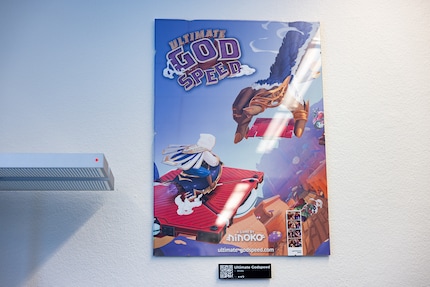
Denise: During my internship at Stray Fawn Studio, I found out that Jan and Pierre wanted to continue their project from their bachelor’s degree. This piqued my interest. Including lockdown and the pandemic, development took three years. This also takes into account everything we learned during the process and were able to implement for the game. We now meet here once a week for in-person work. The rest happens in our home offices – in total, we both work 60 per cent on the game.
** What exactly should I expect from Ultimate Godspeed? **
Pierre: When we go for our short pitch, we like to say it’s akin to Mario Kart, combined with a similarly well-known and successful game, Ultimate Chicken Horse.
Denise: The game itself is basically a kart racing multiplayer. With a twist, as you can place parts, objects and obstacles on the track between individual laps. These can be traps or ramps, for example. After each round, points are awarded in different categories. Before each subsequent round, players add additional pieces to the track, but previous junk remains in place. So the whole thing becomes more and more chaotic.
** So Ultimate Godspeed can be played with several people. Online too? **
Pierre: It started as a local multiplayer game. It’s easier to code, and we’ve had online multiplayer since April. Let’s just say it’s becoming more and more stable. For example, we just had more than four people in a race for the first time. Just five people at once was a huge experience. On your own, but playing with others – without a split screen – is great. Our aim is to make the game playable with eight people. Ultimate chaos. A party racing game, so to speak.
** What do you like most about your job? **
Pierre: I can work on our project every day and carry out my craft to the fullest. And this craft has many, many facets. We deal with audio, concepts, programming and animation. That’s what I particularly like about developing games. But, of course, we also have to go out and show ourselves off. It’s why we were at Gamescom in Cologne this year, for example. And at the Game Developers Conference (GDC) in San Francisco in March.
** Game fairs in Cologne and San Francisco? Sounds fantastic! **
Pierre: Yeah, sounds great at first. And it was all made possible and organised by Pro Helvetia under the banner of Swiss Games. These experiences are very impressive and valuable, but require an enormous amount of time and work. Preparation and follow-up, but also being present. San Francisco alone took up ten days – during which we didn’t work on the game. We also took part in various workshops a month earlier and got in touch with others. Before an event like Gamescom, we arrange meetings with important people and financial backers. However, we also tackle other time-intensive tasks in our everyday lives, such as bookkeeping or completing tax returns.
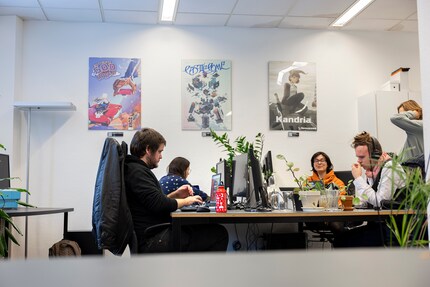
** Your job seems exciting. Nevertheless, there are very few successful studios in Switzerland – especially compared to other countries… **
Pierre: That’s true. When I think of successful Swiss game studios, the first one that comes to mind is Stray Fawn. Then there’s Okomotive with Far and Far 2, and of course Giants with Farming Simulator.
** Why do you think there are so few successful studios here? **
Denise: It’s definitely a financial issue. You can’t open a studio with nothing. But to finance it, you first have to release a game that generates money. And without experience, you can’t join anyone. It’s a vicious circle.
Pierre: Alternatively, I can’t just go to a publisher and say we want to get paid 5,000 francs a month for our upcoming game. Looking at the international market, a publisher knows what a team of 20 people costs in Poland, for example. Swiss devs are extremely expensive in comparison.
In Switzerland, there’s very little arts funding of places where you can join as a game developer. Specifically, I can only think of two contact points for German-speaking Switzerland. Pro Helvetia, which I mentioned earlier, awards grants in various categories twice a year. You can be awarded up to 50,000 francs. This may sound like a lot, but in our team of three it’d be used up after three months of salary payments. Migros also has a funding programme for narrative games. That’s it. Pretty poor compared to the rest of Europe.

Denise: Exactly. Other countries offer specific funding or other support. In Canada, for example, you’ll get a tax break if you create jobs with your studio or game.
Pierre: Networking is incredibly important precisely because of this financial hurdle. Video games are a scene all on their own. One that’s culturally recognised elsewhere in the world. Here in Switzerland, this recognition as a cultural asset is unfortunately still lacking. Here, for example, a card game such as Jass is given much more attention. The next generation might replace it with Tichu. But video games are still a long way off. And naturally, this is reflected economically, with little investment in the scene. That’s why Pro Helvetia’s work is so important.
** Every now and then you’ll read headlines about studios abroad closing. Things don’t look so rosy any more then, no? **
Pierre: The games industry is much bigger than the music or film industry. And of course, people are always trying something new, especially in this industry. But I feel the biggest problem is that gaming never adapted to inflation. Today, a game costs around 60 francs on average. I used to buy PlayStation games for the same price. And I’m convinced that I can now get a game of equal quality for less, even if it still needs updates. This doesn’t really make sense.
Then there’s large companies that invest in a smaller studio in the hope that they’ll be bought out. But when the studio isn’t profitable, it has to close again. In the best case, this’d happen sooner rather than later, of course.
** Would you still buy a 60-franc game if it were adjusted for inflation and cost 120 francs? **
Pierre: (laughs) Well, I’d look at things very differently, of course. I guess we all have a huge Steam backlog of games we’ve never finished. I’m the kind of person who likes to bring back games from my childhood too. Right now it’s Kingdom Hearts, which I played when I was 14.
** What if I want to get started as a game developer myself? Where do I start? **
Pierre: In my case, graphic design helped me get into Frantic. And that eventually led to game design. The development was gradual, even during my studies. My first three semesters at ZHdK were very enjoyable. I felt that I’d learned a lot there and had been challenged. But the following semesters were pretty much a wash for me. I realised that I’d actually already taught myself most of the things I know.
My best teacher was YouTube.
At ZHdK, you shouldn’t expect someone to take you by the hand and give you in-depth insights into an engine, for example, or how you should code. However, you’re taught concepts that you then apply yourself. My best teacher was YouTube. You can discover a lot about popular engines like Unity and Godot there.
Denise: My experience in graphic design definitely helped. But your most important trait has to be working independently. A game is a massive project. You have to be extremely organised and always find something to work on. This also takes a lot of motivation.
In my work as a graphic designer, I was used to implementing customers’ ideas and wishes. Even if I had leeway in the execution, it gave me a framework. And during my studies, the motto was: do what you want. Well, what did I want? It was a completely new art form I had to get into.
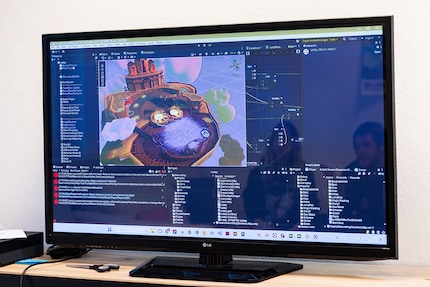
Pierre: My personal recommendation is to start with something smaller. Entering the 3D sector with online multiplayer from the off was very brave. We’re able to handle it now, but it involved an extreme learning curve. After initial input from someone, you can build on this with YouTube tutorials.
** And step by step, you made your first game. **
Pierre: Exactly. We want to officially finish work on Ultimate Godspeed in March. The release is in June. Over the last three years, we learned a lot that we can build on. This gives us a great groundwork for a new project.
** Sounds great. I’m really looking forward to your game and am ready for a round of Ultimate Godspeed. Thank you both for this exciting look behind the curtain! **
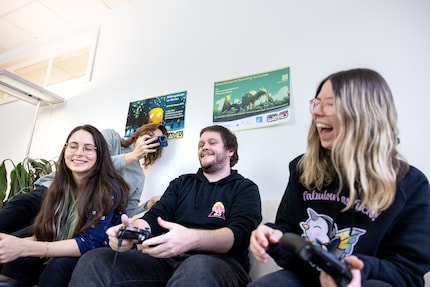
Header image: Christian Walker
In my world, Super Mario chases Stormtroopers with a unicorn and Harley Quinn mixes cocktails for Eddie and Peter at the beach bar. Wherever I can live out my creativity, my fingers tingle. Or maybe it's because nothing flows through my veins but chocolate, glitter and coffee.
Interesting facts about products, behind-the-scenes looks at manufacturers and deep-dives on interesting people.
Show all